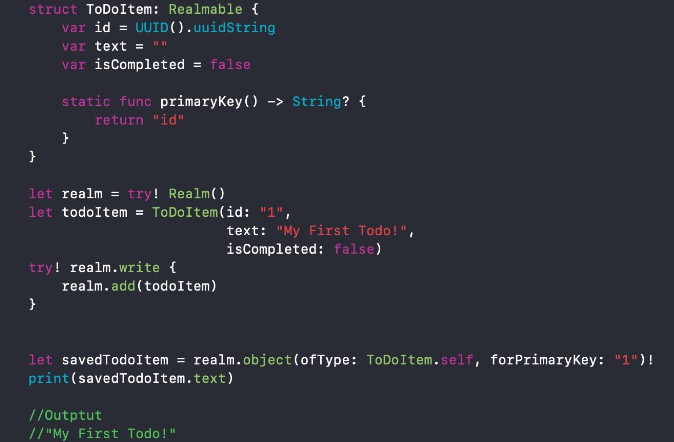RealmWrapper
RealmWrapper is wrapper library for RealmSwift in realm-cocoa
If you use RealmWrapper, you can easily use UI update through Notification and Transaction processing.
Also, you do not have to worry about the retain cycle when using self in the Notification block.
At a Glance
If you use RealmSwift, you have to be careful about try statement and thread processing every transaction.
However, In RealmManageable which manages one realm file, transaction processing is performed using Realm-only DispatchQueue.
RealmProxiable, which owns RealmManageable, can easily add, modify or delete models without having to worry about try statement and thread processing.
User Model
@objcMembers
class User: Object {
dynamic var id: String?
dynamic var name: String?
override static func primaryKey() -> String? {
return "id"
}
}
var user = User()
user.id = UUID().uuidString
user.name = "Kevin"
Using RealmSwift
let realm = try! Realm(configuration: Realm.Configuration(fileURL: URL(fileURLWithPath: RLMRealmPathForFile("user.realm")), schemaVersion: 1, objectTypes: [User.self]))
try! realm.write {
realm.add(user)
}
Using RealmWrapper
UserRealmManager().transaction(writeHandler: { (realm) in
realm.add(user)
})
UserRealmProxy().append(user)
Threading
- By default, you can use the transaction function to process a Realm Transaction in MainThread
UserRealmManager().transaction(writeHandler: { (realm) in
realm.add(user)
})
- It can be implemented by a background thread using DispatchQueue and isSync parameters.
UserRealmManager().transaction(isSync: false, writeHandler: { (realm) in
realm.add(user)
})
UserRealmManager().transaction(writeQueue: DispatchQueue(label: "background"), isSync: false, writeHandler: { (realm) in
realm.add(user)
})
- You can add completion closure.
UserRealmManager().transaction(isSync: false, writeHandler: { (realm) in
realm.add(user)
}) { (realm, error) in
self.tableView.reloadData()
}
Getting Started
- Create a
RealmManagerthat manages one realm file.
final class UserRealmManager: RealmManageable {
var isUseInMemory: Bool {
return false
}
var schemaVersion: UInt64 {
return 1
}
var fileName: String {
return "user"
}
var objectTypes: [Object.Type]? {
return [User.self]
}
}
- Create a
RealmProxythat is responsible for the CRUD function to be accessed by the Controller.
struct UserRealmProxy<RealmManager: UserRealmManager>: RealmProxiable {
var users: RealmQuery<User> {
return query(sortProperty: "date", ordering: .ascending)
}
func append(_ user: User) {
rm.transaction(writeHandler: { (realm) in
realm.add(user, update: .all)
})
}
func delete(_ user: User) {
rm.transaction(writeHandler: { (realm) in
realm.delete(user)
})
}
func updateName(id: String, name: String, age: Int) {
guard let user = userFromId(id) else {return}
rm.transaction(writeHandler: { (realm) in
user.name = name
user.age = age
realm.add(user, update: .all)
})
}
func userFromId(_ id: String) -> User? {
return query(filter: "id == '\(id)'").results.first
}
}
var user = User()
user.id = UUID().uuidString
user.name = "Kevin"
UserRealmProxy().append(user)
UserRealmProxy().delete(user)
UserRealmProxy().updateName(id: user.id, name: "Kris")
- If you want to register the notification of the status of the Realm object in the controller, you can register the notification in RealmQuery.
let users: RealmQuery<User> = UserRealmProxy().users
users.setSection(0)
.addInsertNotificationBlock(self) { (self, insertions) in
self.tableView.reloadData()
}
.addModificateNotificationBlock(self) { (self, modifications) in
self.tableView.reloadRows(at: modifications, with: .fade)
}
.addDeleteNotificationBlock(self) { (self, deletions) in
self.tableView.deleteRows(at: deletions, with: .fade)
}
.registerNotification()
Also, since RealmQuery is doing weak handling to prevent the retain cycle, you can use closures without worrying about the retain cycle if you pass only self.
public func addDeleteNotificationBlock<Object: AnyObject>(_ object: Object, block: @escaping (Object, [IndexPath]) -> Void) -> Self {
deleteNotificationBlock = { [weak object] (deletions) in
guard let weakObject = object else {return}
block(weakObject, deletions)
}
return self
}
Usage
RealmManageable Property
| Property | Type | Default | Description |
|---|---|---|---|
isUseInMemory |
Bool |
required |
Use InMemory Realm |
fileName |
Bool |
required |
Realm File Name |
appGroupIdentifier |
String? |
nil |
Value for Realm file directory for App Extension |
Example
- run carthage update
$ carthage update --platform iOS
- open RealmWrapper.xcodeproj
$ open RealmWrapper.xcodeproj
- run RealmWrapperExample
Installation
CocoaPods (iOS 9+)
platform :ios, '9.0'
use_frameworks!
target '<Your Target Name>' do
pod 'RealmWrapper'
end
Carthage (iOS 9+)
github "k-lpmg/RealmWrapper"
Swift Package Manager (Swift 5.2+, iOS 11+)
.package(url: "https://github.com/k-lpmg/RealmWrapper.git", .upToNextMajor(from: "1.4.4")),
LICENSE
These works are available under the MIT license. See the [LICENSE]file
for more info.

